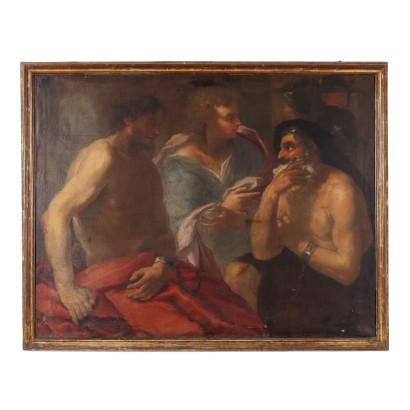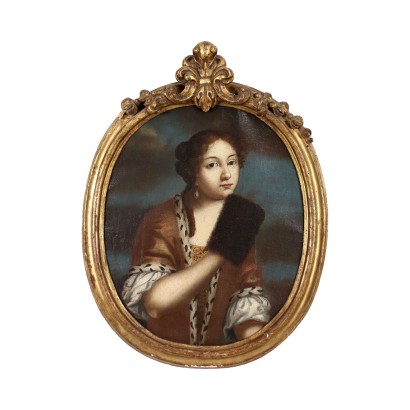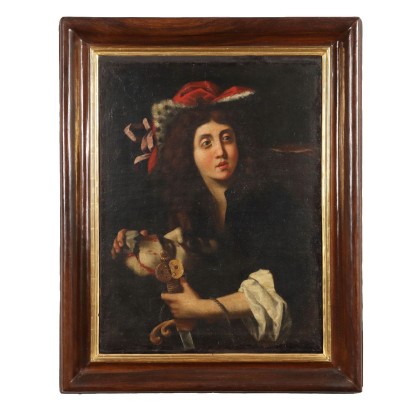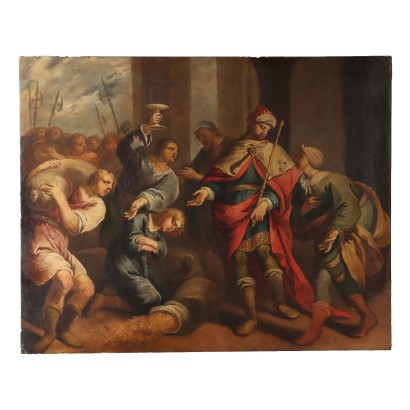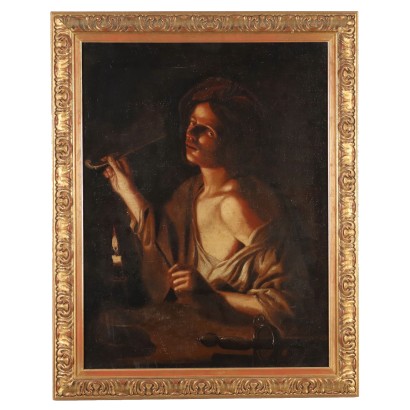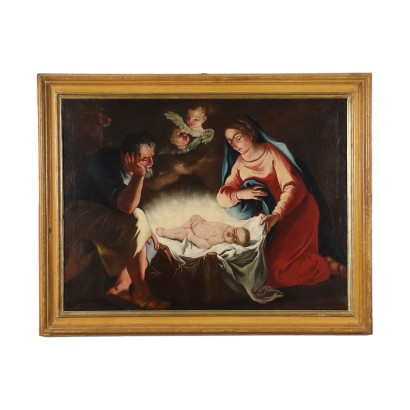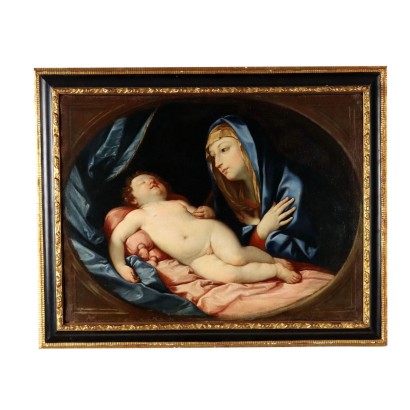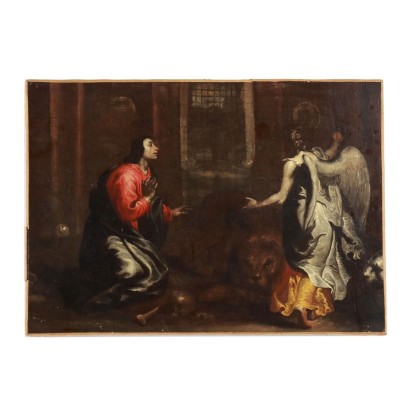Painting from the circle of Johann Carl Loth - Joseph in prison interprets dreams
Features
Joseph in prison interprets dreams
Artist: Johann Carl Loth (1632-1698) Scope of
Artwork title: Giuseppe in prigione interpreta i sogni
Age: 17th Century / 1601 - 1700
Subject: Biblical scene
Artistic technique: Painting
Technical specification: Oil on Canvas
Description : Giuseppe in prigione interpreta i sogni
Oil on canvas. The painting tells the biblical episode of the story of Joseph in which the young man, imprisoned in Egyptian prisons after being sold by his brothers, interprets the dreams of two other prisoners, the cupbearer and the baker of the King of Egypt: his ability to interpret dreams will then lead to obtaining the complacency of the Pharaoh. The painting can be attributed in its pictorial modality to a late eighteenth-century author who looks to the style of Johann Carl Loth, a German painter who settled in Italy, who expressed the baroque taste initially adhering to the naturalistic and dark taste of Giovanni Battista Langetti, and then softened the tones around the seventies and in his late maturity. The painting, in the first canvas, presents slight losses of color. It is presented in a nineteenth-century frame.
Product Condition:
Product in good condition, shows small signs of wear. We try to present the real condition as completely as possible with the photos. If some details are not clear from the photos, what is reported in the description is valid.
Frame Size (cm):
Height: 129
Width: 164
Depth: 4,5
Artwork dimensions (cm):
Height: 117
Width: 152
Additional Information
Artist: Johann Carl Loth (1632-1698)
Born in Munich in 1632, Johann Carl Loth, after an initial artistic training in his homeland, settled in Venice around 1650, where he was probably a pupil of Pietro Liberi, and was particularly influenced by another artist active in those years in the lagoon city, the Genoese Giovan Battista Langetti, trained on the examples of Bernardo Strozzi and Peter Paul Rubens. Loth also stayed in Rome, where he became acquainted with the work of Caravaggio and the Carracceschi, whose influence he was influenced by in his early period. subsequently his painting became lighter and turned to classicism. Loth died in Venice in 1698. Some of his paintings can be admired at the Kunsthistorisches Museum in Vienna, at the Art Institute of Chicago, at the National Gallery in London and in some Venetian churches including that of Santa Maria del Giglio.Age: 17th Century / 1601 - 1700
17th Century / 1601 - 1700Subject: Biblical scene
Artistic technique: Painting
La pittura è l'arte che consiste nell'applicare dei pigmenti a un supporto come la carta, la tela, la seta, la ceramica, il legno, il vetro o un muro. Essendo i pigmenti essenzialmente solidi, è necessario utilizzare un legante, che li porti a uno stadio liquido, più fluido o più denso, e un collante, che permetta l'adesione duratura al supporto. Chi dipinge è detto pittore o pittrice. Il risultato è un'immagine che, a seconda delle intenzioni dell'autore, esprime la sua percezione del mondo o una libera associazione di forme o un qualsiasi altro significato, a seconda della sua creatività, del suo gusto estetico e di quello della società di cui fa parte.Technical specification: Oil on Canvas
The oil painting is a painting technique using powder pigments mixed with bases in inert and oils.Other customers have searched:
Pittura antica, artisti italiani, pittura olio su tela, arte 800, pittura antica, arte novecento, oggetti d'arte, ritratto di signora, dipinto animali, quadro paesaggio montano, dipinto olio su tela, dipinto antico, dipinti natura morta, quadro antico, quadro del '600, pittori italiani quadri olio su tela paesaggi, paesaggio marino dipinto, paesaggio invernale dipinto, paesaggio autunnale dipinto, dipinto di paesaggio, arte antica, quadro religioso..
Se sei un appassionato d'arte, non perderti i nostri approfondimenti sul Blog Arte Di Mano in Mano e su FineArt by Di Mano in Mano - Arte:
Leggi di più
Ecco alcuni tra i principali articoli:
Vedute
Falsi nell'arte antica
Un messaggio di fiducia per ripartire
La potenza espressiva dell'arte figurativa etiope
Breve Storia del Collezionismo
Giorgio Upiglio, maestro dei libri d'artista
Matthias Withoos detto "Calzetta bianca"
San Rocco pensaci tu - Classic Monday
Dai un'occhiata alle nostre rubriche di divulgazione sull'arte:
Epoche
Lavorazioni e tecniche
Mostre ed Eventi
Protagonisti
Se sei appassionato di pittura antica, con tutta probabilità gusterai le schede di questi stupendi quadri:
"Dio parla a Noè dopo il diluvio", Jacopo da Ponte, detto il Bassano, seconda metà XVI secolo
Crocifissione, maestro della misericordia dell'accademia, terzo quarto del XIV secolo
Erminia incontra i pastori, Camillo Gavassetti, Seconda metà anni Venti del XVII Secolo
Eroine dell'antichità, Francesco Conti, XVIII secolo
Hieronymus III Francken, La Negazione di Pietro, XVII secolo
Jefte e la figlia, Girolamo Forabosco e aiuti, XVII secolo
L'Accademia di Platone, piccolo arazzo, fine XVII - inizio XVIII secolo
Maddalena e San Giovanni Battista
Natura Morta, Bartolomeo Arbotori, XVIII secolo
Sacra Famiglia con San Giovannino, Bartolomeo Ramenghi, scuola di, prima metà XVI secolo
Testa Femminile, Andrea del Sarto, ambito di, post 1522
Uva, fichi, melagrana e pesche su un capitello - Maximilian Pfeiler, primo quarto XVIII secolo
Sapevi che l'arte può essere anche un ottimo investimento (e non solo per grandi portafogli)?
L'Arte tra Collezionismo e Investimento
FineArt: Arte come investimento
Leggi di più
Ecco alcuni tra i principali articoli:Vedute
Falsi nell'arte antica
Un messaggio di fiducia per ripartire
La potenza espressiva dell'arte figurativa etiope
Breve Storia del Collezionismo
Giorgio Upiglio, maestro dei libri d'artista
Matthias Withoos detto "Calzetta bianca"
San Rocco pensaci tu - Classic Monday
Dai un'occhiata alle nostre rubriche di divulgazione sull'arte:
Epoche
Lavorazioni e tecniche
Mostre ed Eventi
Protagonisti
Se sei appassionato di pittura antica, con tutta probabilità gusterai le schede di questi stupendi quadri:
"Dio parla a Noè dopo il diluvio", Jacopo da Ponte, detto il Bassano, seconda metà XVI secolo
Crocifissione, maestro della misericordia dell'accademia, terzo quarto del XIV secolo
Erminia incontra i pastori, Camillo Gavassetti, Seconda metà anni Venti del XVII Secolo
Eroine dell'antichità, Francesco Conti, XVIII secolo
Hieronymus III Francken, La Negazione di Pietro, XVII secolo
Jefte e la figlia, Girolamo Forabosco e aiuti, XVII secolo
L'Accademia di Platone, piccolo arazzo, fine XVII - inizio XVIII secolo
Maddalena e San Giovanni Battista
Natura Morta, Bartolomeo Arbotori, XVIII secolo
Sacra Famiglia con San Giovannino, Bartolomeo Ramenghi, scuola di, prima metà XVI secolo
Testa Femminile, Andrea del Sarto, ambito di, post 1522
Uva, fichi, melagrana e pesche su un capitello - Maximilian Pfeiler, primo quarto XVIII secolo
Sapevi che l'arte può essere anche un ottimo investimento (e non solo per grandi portafogli)?
L'Arte tra Collezionismo e Investimento
FineArt: Arte come investimento
Product availability
Immediate availability
Ready for delivery within 2 working days from ordering the product.



